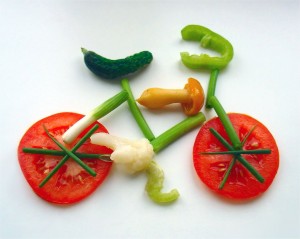
Despite a couple of years of public health initiatives, an explosion in farmers markets, bagged salads, and a White House garden, Americans still don’t eat enough vegetables.
Only 23% of meals include a vegetable (fries don’t count but lettuce on a burger does) and only 17% of dinners prepared at home include a salad (down from 22% in 1994). Salads ordered as a main course at either lunch or dinner in restaurants dropped to 5% (10% in 1989).
Only 26% of America’s adults eat vegetables three or more times a day (not including French fries) according to a study recently released by the CDC, way short of the government’s health objectives set a decade ago, and less than half of what public health officials had hoped.
2010 Dietary Guidelines
The just released 2010 Dietary Guidelines (yes, 2010 released in 2011) recommends that as part of a healthy eating pattern we should increase the amount of vegetables and fruit we eat.
That means filling half your plate with fruit and vegetables. They should be colorful and include a variety of dark green, red, and orange veggies, including beans and peas.
Give Me A Reason I Should Eat More Veggies
Vegetable haters might ask, “Why should I”? There are some really good reasons:
- They’re low in calories
- They’re rich in the nutrients we often lack (folate, magnesium, dietary fiber, Vitamins A, C, and K)
- They may help prevent some chronic diseases
- They’re linked to lower risks for heart attacks, strokes, and some kinds of cancers.
Why We Don’t Eat Them
Just telling people to eat more vegetables obviously isn’t working. People know veggies are good for you but lots of us don’t want to admit that we don’t eat them or even like them.
Honestly, veggies can be a lot of work. How often do you get home, open your fridge, look at the veggies (if they’re in there) and just admit you’re too tired to cook them? Cooking fresh stuff does require time and a commitment. And, unfortunately, poorly cooked vegetables can taste terrible – and, especially for out of season or organic, can be costly. We basically want low cost, tasty, and convenient.
What To Do
- Change your mindset. Eating vegetables needs to become a habit – the go to, the default, instead of chips, or cookies, or fries.
- Think visually: make one half of your plate a color palate of vegetables.
- Don’t be intimidated by them. Learn about them and how to cook them.
- Experiment with ways to make them taste good (hold off on gobs of butter, cheese, and cream, however, or you’re somewhat defeating your total healthy diet purpose). Try cooking with herbs, broth, and big flavor producers like onions, garlic, and peppers.
- Check out the way the food industry is making vegetables easier: fresh cut up vegetables ready to cook; already prepared vegetables to take-out; washed and bagged salad varieties; frozen vegetables ready to pop into the microwave.
- Expose children’s palates to vegetables. Make them the norm. Students who gardened in Berkeley’s “edible schoolyard” program ate one and a half more servings of fruits and vegetables a day than kids who weren’t in the program.
- Work to make vegetables more affordable and available. Support farmers’ markets (some markets allow food stamps to be used), rooftop and urban gardens. Get fresh veggies into schools.
- Plant your own garden or just a pot on the stoop or windowsill.
- Do what you can to make vegetables an easy choice.



